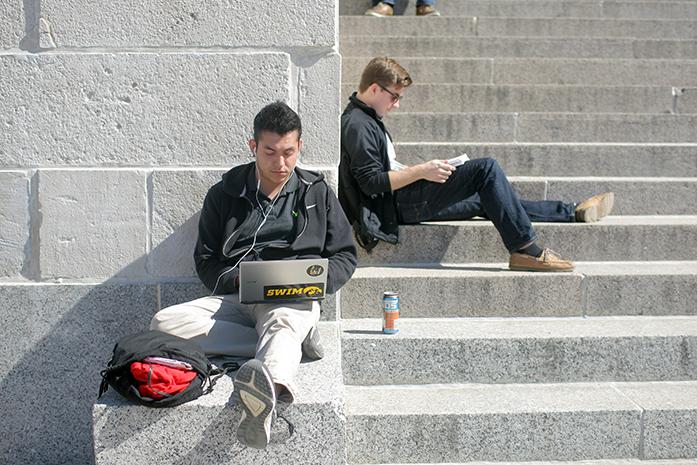By Vivian Le and Isabella Senno
With a population of 30,000 students at the University of Iowa, the power to contribute to community nonprofits can create powerful waves of change that can reach out beyond Iowa City.
Students from the Interdepartmental Studies: Engaged Social Innovation major wanted to use the UI’s power and encourage students to get involved while expanding their experiences in their areas of study.
A group of students from the Fieldwork and Social Innovation course have collaborated on a website called 30,000 Hands that will connect faculty and students to the exact needs of nonprofits in the area.
Madeline Lapage, who she said was motivated by her desire to try to help others, spearheaded the project.
“The world is a very big place, it’s larger than what any of us can come close to imagining,” she said. “… I realized that I can’t achieve that dream, at least not by myself.”
“Much too often, faculty — all in good meaning — will have classes in which they create assignments that connect students to the community but not necessarily respond to the specific needs,” said David Gould, the course instructor.
He said sometimes when unnecessary aid is being given to nonprofits, it can create more work and stress for the organizations. He also noted that sometimes contribution from classes to nonprofits end whenever the course ends.
Students in the course Shannon Nolan, Sarah Beth Weszely, Sydney Hofferber, Lapage, and Kalena Meyer created the website with the help of computer-science student Sydney Knox and communications student Courtney O’Meara.
The website will be a tool for nonprofits to fill out a profile and add specific requests/needs. Those will then be tagged and can be accessed by faculty as they design their curricula to accommodate and encourage community service.
“It’s going to make the city become a classroom,” Gould said.
The students presented 30,000 Hands Thursday night in Van Allen Hall alongside their individual projects they have been working on during the course. The focus of the course was to create value-added projects for the community and fulfill needs.
The Food Pantry at Iowa was a project by Benjamin Marks that was conceived through the program last year. (Disclosure: Marks previously worked as a *DI* Metro editor.)
Although Knox and O’Meara were not students in the Engaged Social Innovation program, they contributed their skills to 30,000 Hands.
“She’s a perfect example of the purpose of the project,” Gould said about Knox. “Because she’s a student with a skill who wanted to do something meaningful and actually build something. She’s been able to use this on her résumé as she’s out looking for internships. She’s what 30,000 Hands will do for many other students.”
In addition to the collaborative project, each student had the opportunity to tackle her or his social concerns.
Weszely
UI junior Weszely could not dedicate herself to one specific issue for her project; she said a multitude of issues demanded attention and care. From LGBT acceptance in the church to police brutality, she could not decide.
Weszley said her indecisiveness led her to the creation of the Attic, a space in which people from the community were welcome to tell their experiences of trauma and injustice through food and art.
“I used art because I thought it would foster a sense of vulnerability and honesty, especially when you’re talking about fear and shame,” Weszley said.
She began by inviting friends and acquaintances to her house, where she lived in the attic. Each meeting would begin with cooking and then each visitor would share a piece of art that reflects an issue such as abuse, racism, sexism, etc.
Then they would all create art in the space, encouraging each other along the way. Songs, poems, collages, paintings, and sketches were all conceived in the space.
As a result, the visitors found themselves breaking barriers and creating new relationships with one another. Conflicting views were set aside, and people were given the ability to connect to each other humanely.
Weszley said she hopes to continue to host these meetings, especially given the aftermath of the election.
— by Vivian Le
Hofferber
Like all of us at times, Hofferber, a UI senior in health and human physiology, drew inspiration from her mother.
Hofferber’s project melds science and art in an animated video meant to encourage proper communication and education about breastfeeding.
According to the Centers for Disease Control and Prevention only 14.1 percent of American mothers breastfeed the recommended amount, and Hofferber’s goal is to move the practice from one that is socially shamed to one that is considered normal.
“My mother had trouble with social pressures when breastfeeding me. She was breastfeeding at a time when you told nurses you were breastfeeding, and they would still give you formula for that inevitable failure,” Hofferber said. “I think that it was harder for her to breastfeed not because she was breastfeeding but because people judged her for breastfeeding.”
Even though she is more focused on science, Hofferber chose to present her project in a more artistic format in order to increase how receptive people would be to it.
“Public-health interventions in general are not effective because they don’t have emotional appeals with logical appeals,” Hofferber said. “My video includes a story line, includes both emotional and logical appeals, and in that respect it should be more effective. It’s a way of combining those to create an environment in which people can find someone that they relate to and want to mimic.”
At the end of the semester, Hofferber still has a lot of work ahead of her, with an International Review Board submission, video-filming process, and lab studies to discover the project’s level of effectiveness in her future.
— by Isabella Senno
Txgx:
Who: Engaged Social Innovation student presenters
What: Presented their group project (30,000 Hands) and their individual projects on a multitude of topics
When: Thursday night
Where: Van Allen Lecture Room 2
Why: To increase awareness about their projects and introduce 30,000 Hands
How: A series of student presenters, first a brief presentation on 30,000 Hands, then students presented their projects







